The most sought after product a lavender farmer produces is lavender essential oil. Have you ever wondered how the oil gets from the plant to your bottle dropper? If so, you’re in luck! I’m going to share the basic process for all you non-chemistry students out there.
How is lavender essential oil made?
There are many different ways to extract essential oil from plants. Steam distillation is the most common way to extract lavender essential oil, and it is the process we use here at the farm.
Steam Distillation is the process of separating the components or substances by using selective boiling and condensation.
What is steam distillation?
According to Wikipedia, steam distillation is “a separation process that consists of distilling water together with other volatile and non-volatile components. The steam from the boiling water carries the vapor of the volatiles to a condenser; both are cooled and return to the liquid or solid state, while the non-volatile residues remain behind in the boiling container.” Steam distillation is often used for extracting volatile essential oils from plant material, and the process of lavender essential oil distillation is sometimes also referred to as “extraction”.
In simplest terms, the process of steam distillation for lavender involves heating water and the plant matter up to the boiling point, capturing the essential oil vapors as they rise, then cooling the vapors and allowing them to condense back into liquid so the essential oil can be collected. That’s it!
Basic Essential Oil Distillation Steps
The basic steps for steam distillation are:
- Place plant material in still
- Boil water under plant matter
- When steam rises through plant matter, collect the oil vapor and steam as they travel into condenser tube
- Cool/condense vapors in tube back into liquid
- Collect essential oil and water (now hydrosol) liquids from tube
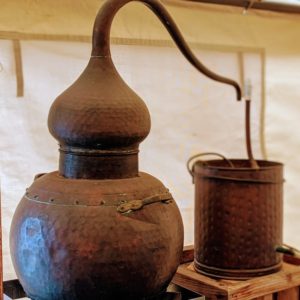
What kind of still do you use to distill lavender essential oil?
We use a traditional 30 gallon copper still, built originally for whiskey distillation and modified slightly for our purposes. The image above is our much smaller, but still functional (and more photogenic), copper demonstration still.
What is the process for a lavender farmer distilling lavender essential oil?
Step 1: Harvest!
The first step in distillation is to harvest the lavender when your yield per run is highest. Different lavender farmers have different methods, preferences, and ideas about when that is. Farmer Rick prefers to wait until the lavender is at the end of its life cycle, when the flowers have died and the buds are just beginning to drop from the plant. Unlike harvesting for bud (where we need long stems to hang dry the lavender), when harvesting for essential oil we try to cut as little stem as possible. While there are trace elements of oil in stems, it isn’t enough to justify the space the stems would take up in the still – we want as much bud stuffed in there as possible to get as much oil as we can out of the run.
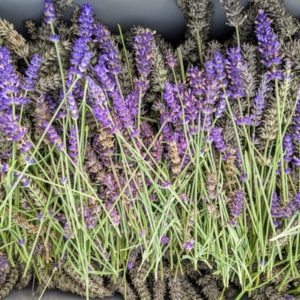
Step 2: Pack Still
After harvest, we tightly pack the lavender in the still. The lavender is packed above a screen to keep the plant material from dropping down into the water (which will boil in the bottom of the still). We pack approximately 40-50lbs of lavender per run (or 10-30 plants, depending on the variety and age of the plant). When the pot is fully packed, we place the bonnet on top.
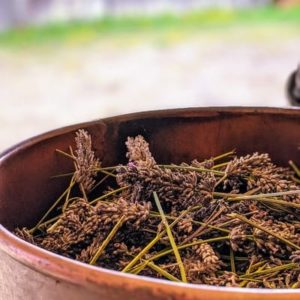
Step 3: Add & Heat Water
Next, we boil the water in the bottom of the still. Since the boiling point of lavender oil (204°F) is lower than water (212°F) then by the time the water boils, the lavender essential oils have already started to vaporize. As the steam and oil vapors rise from the still, the bonnet collects them and forces them into the condenser tube.
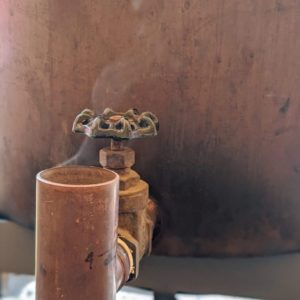
Step 4: Condensation
The next step is to cool the condenser tube, so the steam and oil vapors inside it condense back into liquid. Because the condenser tube is angled down (away from the still), gravity causes the newly condensed liquids to run down the tube and out, where they are collected together in a graduated cylinder. Because oil and water don’t mix, the lavender essential oil floats on top, making it easy to collect. We monitor the temperature throughout this process, with the goal of keeping the temperature of the condensed liquids consistent.
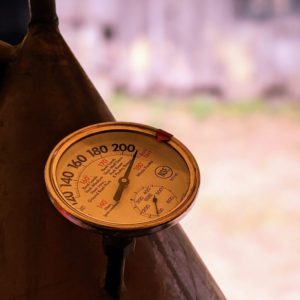
Sidenote: Hydrosol
At this point, the “water” has now been converted to “hydrosol” – a mixture of water (hydro) and soluble material (sol). Lavender Hydrosol has many uses, including as a natural house cleaner. While it is considered a byproduct of the steam distillation process, because of its popularity, most lavender farmers (including us) save and sell the hydrosol. Lavender Hydrosol is 100% natural and contains only water and soluble lavender. It has a distinct grassy, botanical fragrance that is pleasant but uniquely different than lavender essential oil.
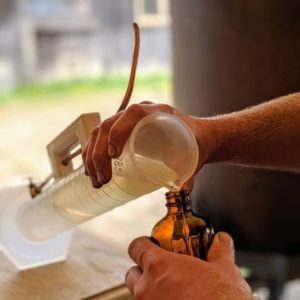
Step 5: Essential Oil
The lavender essential oil is now floating on top of the hydrosol in the graduated cylinder. To collect it, we simply pour it off! As it gets to the bottom of the layer, we use a pipette to gather the very last of the oil from the surface of the hydrosol to avoid pouring any hydrosol in with the oil.
Why is pure lavender essential oil so expensive?
The entire process, from harvest to completion, takes approximately three hours, and anywhere from 10-30 lavender plants. Each run of lavender produces a different amount of oil, depending on a multitude of factors, including the lavender variety, weather conditions/yield that season, how tightly the still was packed, etc. A three hour run can produce as little as 60ml or more than 700ml of lavender essential oil. Part of the nuance of lavender farming is taking good notes, doing good research, and paying attention to your crops to determine which lavender to distill and when to distill it. Think of it this way: it takes 50 lbs of plant matter and three hours of distillation time (not including the time to grow and care for the plants), just to produce a bottle or two of oil. That’s a lot of lavender love!
We are fortunate to have so many different varieties at our farm to experiment with. Over the years we continue to select and refine which varieties of lavender we (and our customers) love in their essential oil form – and we now offer 18 varieties of lavender essential oil for sale online! Hopefully, this blog gave you a better understanding of the time and process it takes to get that drop of essential oil from our farm to your diffuser. (And if you’re ever in Sequim during the summer, stop by Lavender Connection and you can watch the distillation process in person and smell the different varieties at our Essential Oil Bar – it’s like a wine tasting, for your nose!)
6 Replies to “Lavender Essential Oil: How is it made?”
Barb Muhl Comstock
I was very excited to see your reminder email…. time to order! Unfortunately, and I realize it may be difficult, but can you explain the difference between all your varieties of lavender? I”m looking for essential oil this year, but you have so many choices. Everybody’s noses smell differently, but do you have some basics truisms? Thank you.
Rebecca Olson[ Post Author ]
Barb – hello! Yes, we have many varieties, it’s true. The primary difference between the oils is that intermedia varieties are what I would call “classic”, simply because that’s the type of oil used in most bath/body/home products so it’s the variety most customers are familiar with. The angustifolia oils do not have as much camphor in them, so they don’t have the medicinal undernote that you’re used to with lavender (some words people use to describe angustifolia are sweet, honey, floral, etc.) If you were planning to get oil to use for naturopathic topical treatments (like bug bites) I would recommend intermedia. If you were planning to use the oil for cooking, I would recommend angustifolia. If you’re just looking for something that smells nice, all of them will work! I’ve tried to create a few “tasting notes” in each oil description to help you decide. Our most popular oils are “Row 19” and “Hidcote Pink” – though if you use the “sort by popularity” option in the essential oil page, you’ll see the others ranked by what our customers choose. Keep in mind that most of the bulk oils were only available at the farm (after doing a sampling at our smell bar) up until this fall, so you can trust that if it is popular, it’s because it’s what people liked best after smelling it. Feel free to shoot me an email if you have any other questions!
Debbie
What kind of lavender plant is best for distilling lavender oil?
Rebecca Olson[ Post Author ]
Debbie – it depends on what qualities you’re looking for! You can check out my blog “angustifolia vs. intermedia” for a more in depth breakdown. The intermedia varieties are the best for oil production, and because of this they are more affordable and therefore what is typically used in bath/body products. The most popular lavender for this is “Grosso” which was developed specifically to smell great and produce a lot of oil. The angustifolia varieties typically don’t produce as much oil, but they don’t have as much camphor, so they smell more sweet and floral. There is quite a bit of variety between the different angustifolia oils which make them more unique. Our most popular are “Hidcote Pink”, “Melissa” and “Violet Intrigue”.
Caroline Rider
I just bought some essential lavender oil (not from you) that has a strong “decaying matter” undertone… is this just the variety, or do i need to dilute it, or send it back, or…?
Please put me on your mailing list… I appreciated all the info in your article…
Rebecca Olson[ Post Author ]
Caroline – that’s a great question! Every variety of lavender essential oil has unique fragrance notes that are perceptible when you are smelling them next to each other, and the two different species we sell (angustifolia and intermedia) are different enough that you can tell which species you’re smelling even when its by itself. You can pick up subtle notes of “sweet” or “medicinal” or “citrus” – but basically, lavender should simply smell pleasantly of lavender – not decaying matter. There are a few things I can think of that could be the issue:
-This is a combination of oils of different species/varieties that don’t smell good together to you;
-The oil wasn’t stored properly (it got hot or oxygenated) and is now “off”. Typically this makes the oil smell sharp/vinegary (not decaying) but it’s possible this is how your nose is registering it;
-The oil you have is not pure essential oil and has been cut with another oil, like coconut, which has gone rancid.
I’m not sure if its worth it to you to try and address it with the company you bought it from, but I know if someone purchased an oil from us that smelled like decaying matter I would want them to let me know and exchange it for another bottle (or another kind).
Hope that helps! I added you to the newsletter – you can opt out any time.